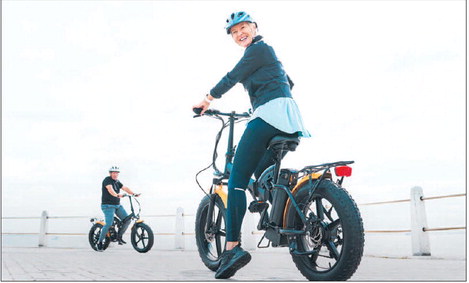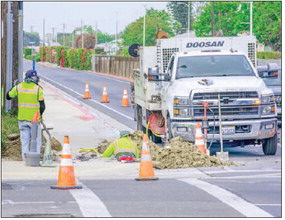E-bikes pose unique risks to riders


by Eloy Gomez
GRF safety manager
Over the past few years, electric bikes have grown in popularity as a fun, energyeffi cient way to get around the community while offering some health benefits. Despite being an affordable and flexible form of travel, new reports highlight a surge in accidents and dangers associated with these types of motorized vehicles that can result in severe injuries, such as broken bones, spinal cord and head injuries.
The Department of Motor Vehicles defines an ebike as a bicycle equipped with fully operable pedals and an electric motor. Most e-bikes fall into one of three types.
Class 1 e-bikes, the most common, are pedal-assist models with motors that work only while someone is pedaling. They have a top speed of 20 mph. Ride faster, and the motor automatically flips off.
Class 2 e-bikes feature a throttle, so the motor powers the bike even if a person isn’t pedaling. It stops working if a person exceeds 20 mph, though.
Class 3 e-bikes are the most powerful. These pedalassist bikes can reach 28 mph before the motor stops.
Electric bikes are much heavier than traditional bikes because they contain a battery and an electric motor, weighing anywhere around 30-80 pounds.
According to an article by the Washington Post, some dangers come with owning or using electric bikes, and it’s essential to be aware of them. Because of weight and speed, e-bikes pose a greater risk of injury to riders and pedestrians. A Reuters report found that e-bike injuries were more than three times as likely to involve a collision with a pedestrian than either scooter or traditional bike injuries. Those injuries were more serious than with other types of motorized vehicles such as scooters and conventional bikes, according to recent studies.
Fire and safety officials are also warning that consumers need to take precautions with electric bikes after an increase in battery fires linked to the devices. Lithiumion batteries, the type used to power e-bikes, have been found to overheat and catch fire under certain conditions, especially if they are not charged or disposed of properly.
Last year, New York fire officials reported over 75 e-bike fires, which caused multiple injuries and three deaths. Last month, an ebike’s battery burst into flames while charging in a New York restaurant, which injured one firefighter.
Consumer Reports recently outlined some tips fire officials have offered to stay safe:
• Purchase and use devices that are certified by a qualified testing laboratory.
• Always use the manufacturer’s cord, and power adapter explicitly made for the device.
• Store batteries away from anything flammable.
• Do not leave e-bikes unattended while they’re charging, and don’t leave them charging overnight.
• Do not block your primary way into and out of the building with an e-bike.
In many e-bike accidents, the braking system was reported to have caused heavy vibration, metal to metal grinding and inability to bring the bike to a complete stop. Due to e-bikes’ heavier weight, combined with greater speeds, the wear and tear on the braking system is much greater as the brake pads might wear out up to 75% faster than those in traditional bikes. Don’t forget to inspect e-bike brakes or have them serviced at a professional e-bike repair shop on a regular basis.
Electric bike accident injuries are often devastating for victims. Along with the immense physical and emotional pain and suffering these injuries can cause, victims often incur tremendous medical expenses and a lowered quality of life after the incident. Wearing a helmet may reduce the impact of such injuries. Currently California law requires Class 3 e-bike riders of any age to wear helmets; however, it is good practice to wear a helmet when riding any type of bike.
People who are planning on purchasing an e-bike or have not used an e-bike in some time should practice riding in an empty parking lot or other open, traffic-free space to practice starting and slowing the e-bike. An e-bike’s acceleration can startle new riders, as can the distance required to fully stop, and the weight that could contribute to a loss of balance.
Remember to be considerate and courteous when riding. The pedestrian always has the right of way. An e-bike, like any regular bicycle, is a vehicle and is required to follow all roadway rules and regulations:
• Act like a car, be predictable and visible.
• Wear bright or reflective clothing.
• Look out for other roadway users and never assume they will see you especially at intersection.
• Use the e-bike’s bell or politely say “on your left” when passing.
For more information, contact Safety Manager Eloy Gomez at 562-431-6586, ext. 356.
A Reuters report found that e-bike injuries were more than three times as likely to involve a collision with a pedestrian than either scooter or traditional bike injuries.





